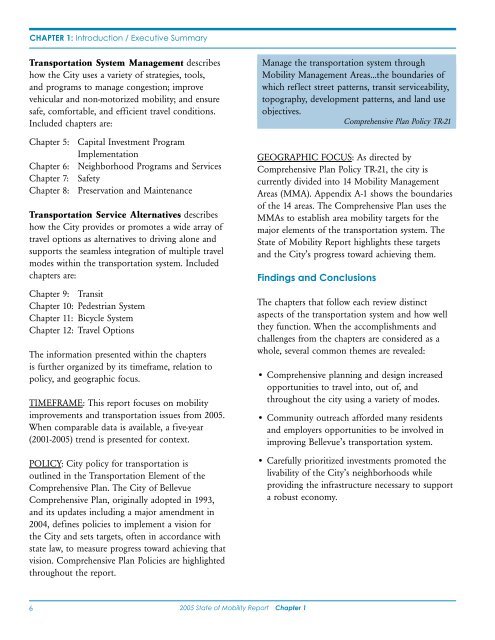2005 State of Mobility Report - City of Bellevue
2005 State of Mobility Report - City of Bellevue
2005 State of Mobility Report - City of Bellevue
You also want an ePaper? Increase the reach of your titles
YUMPU automatically turns print PDFs into web optimized ePapers that Google loves.
CHAPTER 1: Introduction / Executive Summary<br />
Transportation System Management describes<br />
how the <strong>City</strong> uses a variety <strong>of</strong> strategies, tools,<br />
and programs to manage congestion; improve<br />
vehicular and non-motorized mobility; and ensure<br />
safe, comfortable, and efficient travel conditions.<br />
Included chapters are:<br />
Chapter 5: Capital Investment Program<br />
Implementation<br />
Chapter 6: Neighborhood Programs and Services<br />
Chapter 7: Safety<br />
Chapter 8: Preservation and Maintenance<br />
Transportation Service Alternatives describes<br />
how the <strong>City</strong> provides or promotes a wide array <strong>of</strong><br />
travel options as alternatives to driving alone and<br />
supports the seamless integration <strong>of</strong> multiple travel<br />
modes within the transportation system. Included<br />
chapters are:<br />
Chapter 9: Transit<br />
Chapter 10: Pedestrian System<br />
Chapter 11: Bicycle System<br />
Chapter 12: Travel Options<br />
The information presented within the chapters<br />
is further organized by its timeframe, relation to<br />
policy, and geographic focus.<br />
TIMEFRAME: This report focuses on mobility<br />
improvements and transportation issues from <strong>2005</strong>.<br />
When comparable data is available, a five-year<br />
(2001-<strong>2005</strong>) trend is presented for context.<br />
POLICY: <strong>City</strong> policy for transportation is<br />
outlined in the Transportation Element <strong>of</strong> the<br />
Comprehensive Plan. The <strong>City</strong> <strong>of</strong> <strong>Bellevue</strong><br />
Comprehensive Plan, originally adopted in 1993,<br />
and its updates including a major amendment in<br />
2004, defines policies to implement a vision for<br />
the <strong>City</strong> and sets targets, <strong>of</strong>ten in accordance with<br />
state law, to measure progress toward achieving that<br />
vision. Comprehensive Plan Policies are highlighted<br />
throughout the report.<br />
Manage the transportation system through<br />
<strong>Mobility</strong> Management Areas…the boundaries <strong>of</strong><br />
which reflect street patterns, transit serviceability,<br />
topography, development patterns, and land use<br />
objectives.<br />
Comprehensive Plan Policy TR-21<br />
GEOGRAPHIC FOCUS: As directed by<br />
Comprehensive Plan Policy TR-21, the city is<br />
currently divided into 14 <strong>Mobility</strong> Management<br />
Areas (MMA). Appendix A-1 shows the boundaries<br />
<strong>of</strong> the 14 areas. The Comprehensive Plan uses the<br />
MMAs to establish area mobility targets for the<br />
major elements <strong>of</strong> the transportation system. The<br />
<strong>State</strong> <strong>of</strong> <strong>Mobility</strong> <strong>Report</strong> highlights these targets<br />
and the <strong>City</strong>’s progress toward achieving them.<br />
Findings and Conclusions<br />
The chapters that follow each review distinct<br />
aspects <strong>of</strong> the transportation system and how well<br />
they function. When the accomplishments and<br />
challenges from the chapters are considered as a<br />
whole, several common themes are revealed:<br />
• Comprehensive planning and design increased<br />
opportunities to travel into, out <strong>of</strong>, and<br />
throughout the city using a variety <strong>of</strong> modes.<br />
• Community outreach afforded many residents<br />
and employers opportunities to be involved in<br />
improving <strong>Bellevue</strong>’s transportation system.<br />
• Carefully prioritized investments promoted the<br />
livability <strong>of</strong> the <strong>City</strong>’s neighborhoods while<br />
providing the infrastructure necessary to support<br />
a robust economy.<br />
<br />
<strong>2005</strong> <strong>State</strong> <strong>of</strong> <strong>Mobility</strong> <strong>Report</strong> Chapter 1

















